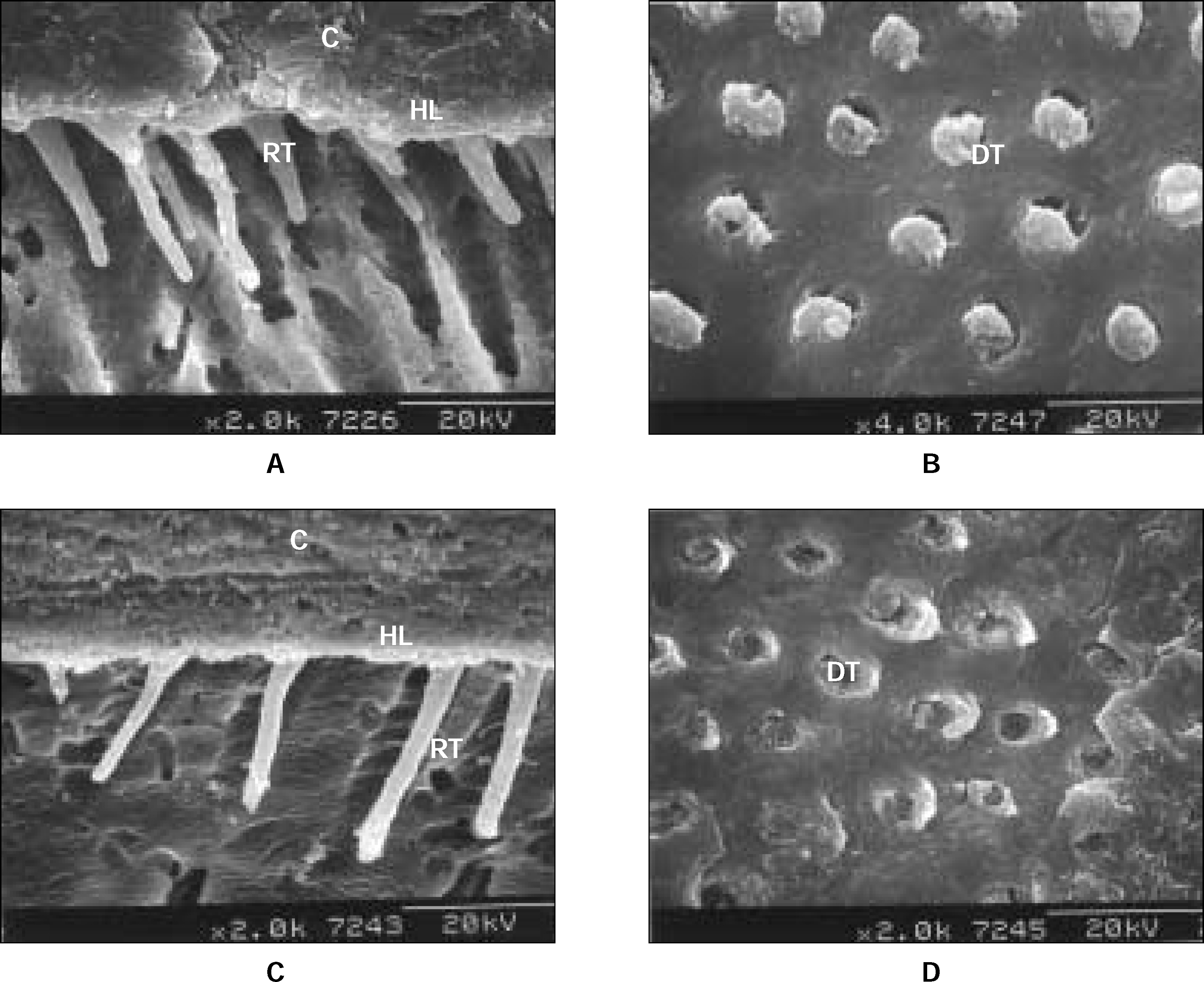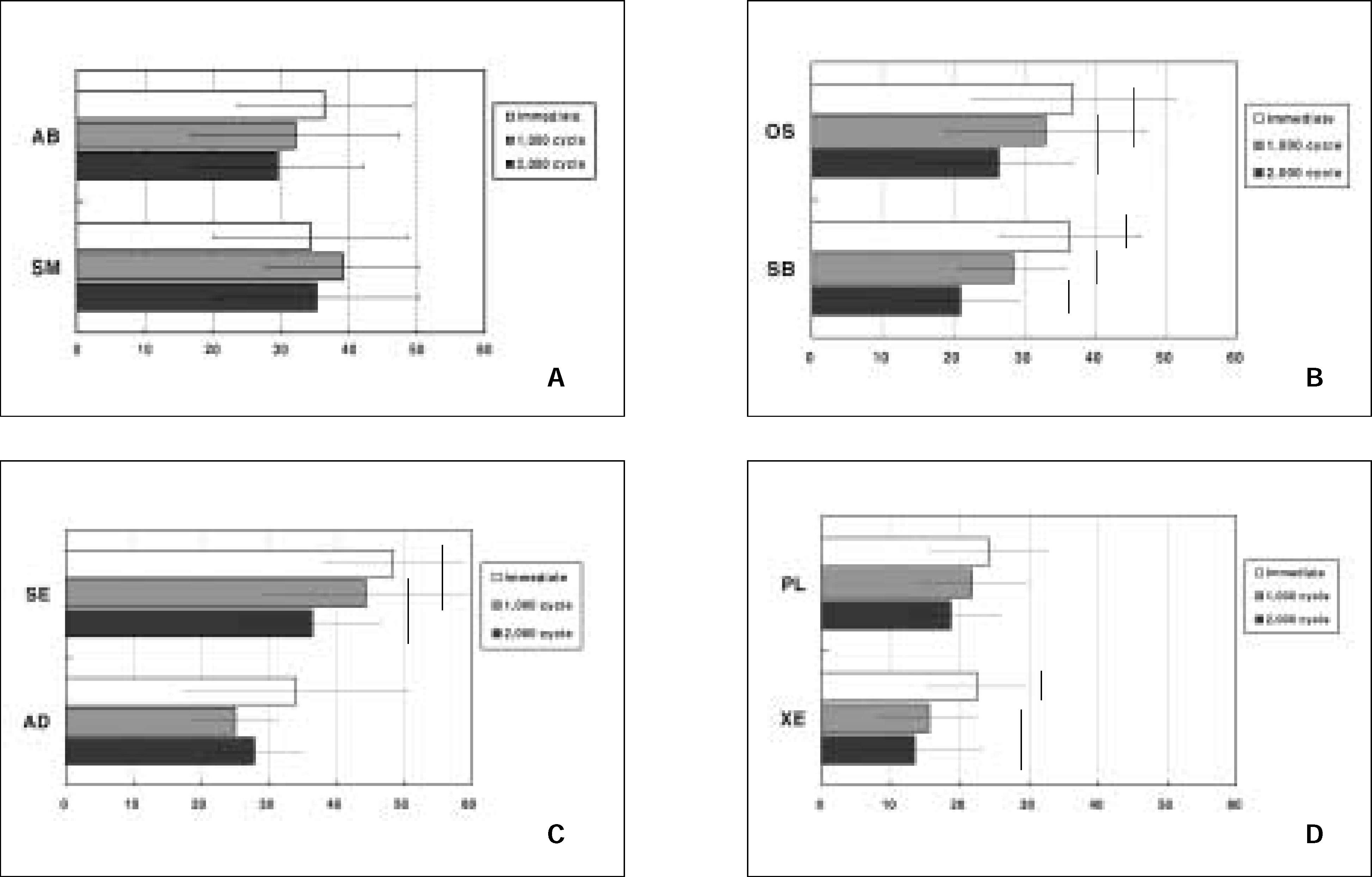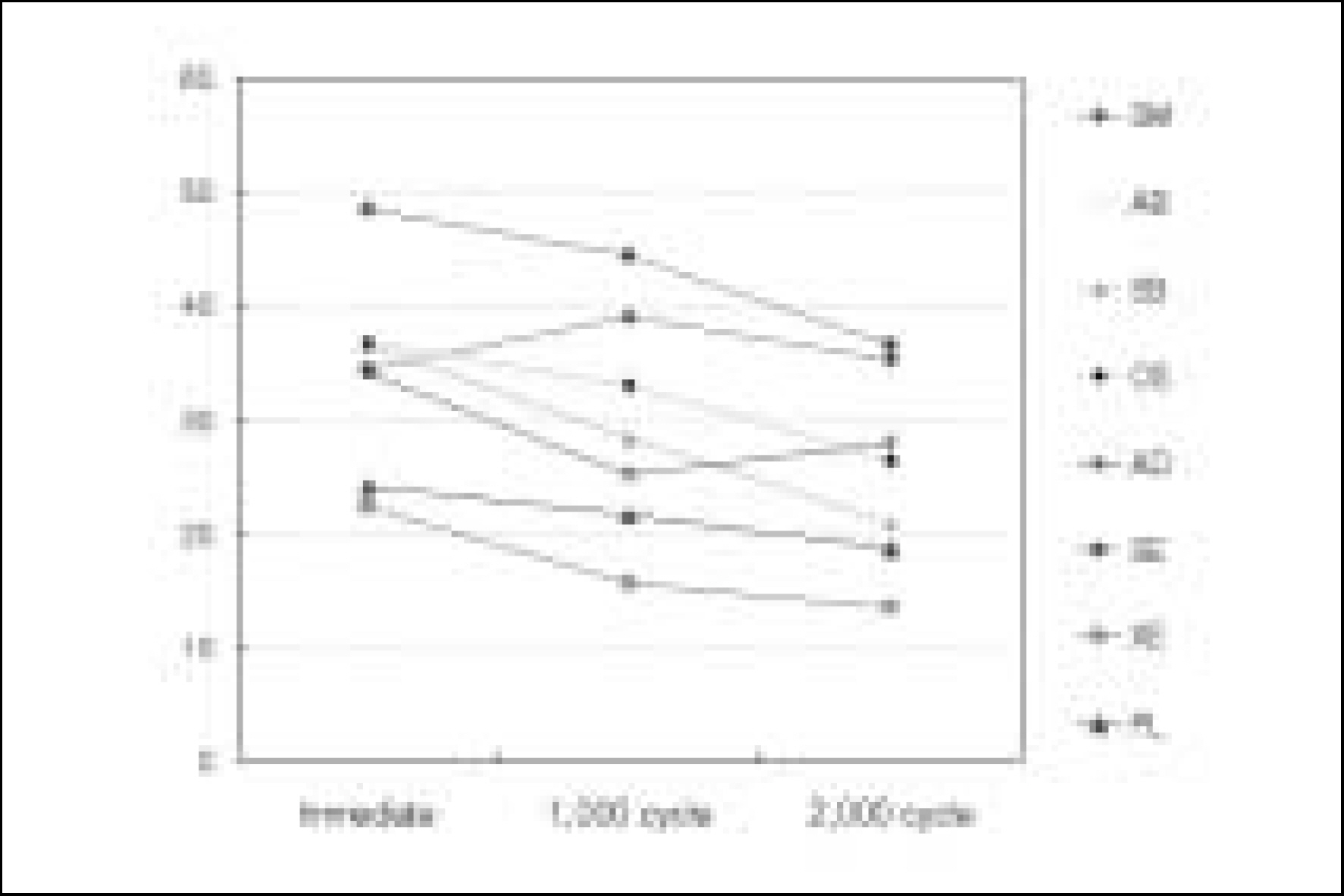Articles
- Page Path
- HOME > Restor Dent Endod > Volume 32(3); 2007 > Article
- Original Article THE EFFECT OF THERMOCYCLING ON THE DURABILITY OF DENTIN ADHESIVE SYSTEMS
- Young-Hoon Moon, Jong-Ryul Kim, Kyung-Kyu Choi, Sang-Jin Park,*
-
J Korean Acad Conserv Dent 2007;32(3):-235.
DOI: https://doi.org/10.5395/JKACD.2007.32.3.222
Published online: January 14, 2007
Department of Conservative Dentistry, Division of Dentistry, Graduate of Kyung Hee University
- *Corresponding Author: Sang-Jin Park, Department of Conservative Dentistry, Division of Dentistry, Graduate of Kyung Hee University 1, Hoegi Dong, Dongdaemun Gu, Seoul, Korea, 130-702, Tel: 82-2-958-9335 E-mail: psangjin@khu.ac.kr
Copyright © 2007 The Korean Academy of Conservative Dentistry
This is an Open Access article distributed under the terms of the Creative Commons Attribution Non-Commercial License (http://creativecommons.org/licenses/by-nc/3.0) which permits unrestricted non-commercial use, distribution, and reproduction in any medium, provided the original work is properly cited.
- 1,375 Views
- 8 Download
- 2 Crossref
Abstract
-
The objectives of this study was to evaluate the effect of thermocycling on the μTBS (microtensile bond strength) to dentin with four different adhesive systems to examine the bonding durability.Freshly extracted 3rd molar teeth were exposed occlusal dentin surfaces, and randomly distributed into 8 adhesive groups: 3-steps total-etching (Scotchbond Multi-Purpose Plus; SM, All Bond-2; AB), 2-steps total-etching (Single Bond; SB, One Step plus; OS), 2-steps self-etching (Clearfil SE Bond; SE, AdheSE; AD) and single-step self-etching systems (Promp L-Pop; PL, Xeno III; XE). Each adhesive system in 8 adhesives groups was applied on prepared dentin surface as an instruction and resin composite (Z250) was placed incrementally and light-cured. The bonded specimens were sectioned with low-speed diamond saw to obtain 1 × 1 ㎜ sticks after 24 hours of storage at 37 °C distilled water and proceeded thermocycling at the pre-determined cycles of 0, 1,000 and 2,000. The μTBS test was carried out with EZ-tester at 1 mm/min. The results of bond strength test were statistically analyzed using one-way ANOVA/ Duncan's test at the α〈 0.05 confidence level. Also, the fracture mode of debonded surface and the interface were examined under SEM.The results of this study were as follows;
3-step total etching adhesives showed stable, but bond strength of 2-step adhesives were decreased as thermocycling stress.
SE showed the highest bond strength, but single step adhesives (PL, XE) had the lowest value both before and after thermocycling.
Most of adhesives showed adhesive failure. The total-etching systems were prone to adhesive failure and the single-step systems were mixed failure after thermocycling.
Within limited results of this study, the bond strength of adhesive system was material specific and the bonding durability was affected by the bonding step/ procedure of adhesive. Simplified bonding procedures do not necessarily imply improved bonding performance.



A. 3 step adhesive, B. 2 step total-etching adhesive, C. 2 step self-etching adhesive, D. 1 step self-etching adhesive. Vertical bar means the statistical significance in same adhesive.


A. Immediate tested specimen. Hybrid layer was formed uniformly and resin tags were deeply infiltrated into dentinal tubules so that formed lateral braches. B. A specimen after 2,000 thermocycling. Note some gaps on the top of hybrid layer. C. Mixed failed surface that adhesive failure at the top or bottom of hybrid layer in upper side and cohesive failure of composite in lower side of micrograph (HL: Hybrid Layer, C: Composite Resin, RT: Resin Tag, DT: Dentinal Tubule).

A. Immediate tested specimen. Relative thin hybrid layer that was well integrated without defect was formed uniformly and resin tags were deeply infiltrated into dentinal tubules. B. A specimen after 2,000 thermocycling. Some broken resin tags below hybrid layer were observed though long tags were formed (HL: Hybrid Layer, C: Composite Resin, RT: Resin Tag, DT: Dentinal Tubule).

A. Immediate tested specimen bonded with PL. Relative thicker hybrid layer was formed uniformly and well demarcated from adhesive layer and greater number of resin tags were deeply infiltrated into dentinal tubules that was connected each other by lateral braches. B. Fractured surface of PL after 2,000 thermocycling shows adhesive failure that peritubular dentin is remained partially. C. Adhesive failed surface of PL 2,000 group. Adhesive layer is a worm-eaten appearance that allows water movement between the interface and the underlying hydrated dentin. D. A specimen after 2,000 thermocycling. Note some gaps between adhesive layer and top of hybrid layer (HL: Hybrid Layer, C: Composite Resin, RT: Resin Tag, DT: Dentinal Tubule).
- 1. Raskin A, Mechotte-Theall B, Vreven J, Wilson NH. Clinical evaluation of a posterior composite 10-year report. J Dent 27:130-19. 1999.Article
- 2. Wilder AD, May KN, Bayne SC, Taylor DF, Leinfelder KF. Seventeen year clinical study of ultraviolet-cured posterior composite class I and II restorations. J Esthetic Dent 11:135-142. 1999.Article
- 3. Sano H, Takatsu T, Ciucchi B, Horner JA, Matthews WG, Pashley DH. Nanoleakage: leakage within the hybrid layer. Oper Dent 20:18-25. 1995.PubMed
- 4. Yoshida Y, Van Meerbeeek B, Nakayama Y, Snauwaert J, Hellemans L, Lambrechts P, Vanherle G, Wakasa K. Evidence of chemical bonding at biomateri-al?hard tissue interfaces. J Dent Res 79:709-714. 2000.ArticlePubMedPDF
- 5. Primenta LAF, Amaral CM, Bredrane de Castro AKB, Ritter AV. Total-etch, deproteinization and self-etching. Oper Dent 29:592-598. 2004.PubMed
- 6. Paul SJ, Welter DA, Ghazi M, Pashley D. Nanoleakage at the dentin adhesive-interface vs. microtensile bond strength. Oper Dent 24:181-188. 1999.PubMed
- 7. Giannini M, Seixas CAM, Reis AF, Pimenta LAF. Six-month storage-time evaluation of one-bottle adhesive systems to dentin. J Esth Rest Dent 15:43-49. 2003.Article
- 8. Tay FR, Pashley DH, Yoshiyama M. Two mondes of nanoleakage expression in single-step adhesives. J Dent Res 81:472-476. 2002.ArticlePubMedPDF
- 9. Carracho AJL, Chappell RP, Glaros AG, Purk JH, Erick JD. The effect of storage and thermocycling of the shear bond strength of three dental adhesive. Quintessence Int 22:745-752. 1991.PubMed
- 10. Marshall GW, Marshall SJ, Kinney JH, Balooch M. The dentine substrate: structure-and properties related to bonding. J Dent 25:441-458. 1997.PubMed
- 11. Ferracane JL, Berge JR, Condon JR. In vitro aging of dental composites in-water-effect of conversion, filler volume, and filler/ matrix coupling. J Biomed-Mater Res 42:465-472. 1998.PubMed
- 12. Gale MS, Darvel BW. Thermal cycling procedures for laboratory testing of dental restorations. J Dent 27:89-99. 1999.ArticlePubMed
- 13. Sano H, Yoshikawa T, Pereira PNR, Kanemura N, Morigami M, Tagami J, Pashley . Long-term Durability of dentine bonds made with a self-etching primer, in vivo. J Dent Res 78:906-911. 1999.PubMed
- 14. Tanumiharja M, Burrow MF, Tyas MJ. Microtensile bond strengths of seven-dentine adhesive systems. Dent Mater 16:180-187. 2000.PubMed
- 15. Burrow MF, Satoh M &, Tagami J. Dentin bond durability after three years using a dentin bonding agent with and with-out priming. Dent Mater 12(5):302-307. 1996.ArticlePubMed
- 16. Li HP, Burrow MF, Tyas MJ. The effect of long-term storage on nano-leakage. Oper Dent 26:609-616. 2001.PubMed
- 17. Tay FR, Pashley DH, Suh BI, Carvalho RM, Itthagarun A. Single-step adhesives are permeable membranes. J Dent 30:371-382. 2002.ArticlePubMed
- 18. Kanca 3rd J, Gwinnett AJ. Successful marginal adaptation of a dentin-enamel bonding system in vitro and vivo. J Esthet Dent 6:286-94. 1994.PubMed
- 19. Nakajima M, Kanemura N, Pereira PN, Tagami J, Pashley DH. Comparative microtensile bond strength and SEM analysis of bonding to wet and dentin. Am J Dent 13:324-8. 2000.PubMed
- 20. Reis A, Loguercio AD, Carvalho RM, Grande RH. Durability of resin dentin interfaces: effects of surface moisture and adhesive solvent component. Dent Mater 20(7):669-76. 2004.ArticlePubMed
- 21. Reis A, Loguercio AD, Azevedo CLN, Carvalho RM, Siger JM, Grande RHM. Moisture spectrum of demineralized dentin for different solvent -based adhesive system. J Adhes Dent 5:183-192. 2003.PubMed
- 22. Takahashi A, Inoue S, Kawamoto C, Ominato R, Tanaka T, Sato Y, Pereira PNR, Sano H. In vivo longterm durability of the bond to dentin using two adhesive systems. J Adhes Dent 4:151-159. 2002.PubMed
- 23. Miyazaki M, Sato M, Onose H, Moore BK. Influence of thermal cycling on dentin bond strength of two-step bonding systems. Am J Dent 11:118-122. 1998.PubMed
- 24. Nikaido T, Kunzelman KH, Chen H, Ogata M, Harada N, Yamaguchi S, Cox CF, Hickel R, Tagami J. Evaluation of thermal cycling and mechanical loading on bond strength of a self-etching primer system to dentin. Dent Mater 18:269-275. 2002.ArticlePubMed
- 25. Shirai K, De Munck J, Yoshida Y, Inoue S, Lambrechts P, Suzuki K, Shintani H, van Meerbeek B. Effect of cavity configuration and ageing on the bonding effectiveness of six adhesives to dentin. Dent Mater 21:110-124. 2005.PubMed
- 26. 조영 곤, 반일 환, 유미 경. 상아질 접착 후 저장기간에 따른 접착 제의 접착력의 변화. 대한치과보존학회지 30(3):204-205. 2006.
- 27. Kato G, Nakabayashi N. The durability of adhesion to phosphoric acid etched, wet dentine substrates. Dent Mater 14:347-352. 1998.PubMed
- 28. International Organization for Standardization. ISO TR 11405, Dental materials-guidance on testing of adhesion to tooth structure 1994.
- 29. Hashimoto M, Ohno H, Kaga M, Endo K, Sano H, Oguchi H. In vivo degradation of resin-dentin bonds in humans over 1 to 3 years. J Dent Res 79:1385-1391. 2000.
- 30. Fumiaki K, Takafumi O, Tetsuo I, Naoyuki M. Influence of thermal cycles in water on flexural strength of laboratory-processed composite resin. J Oral Rehabil 703-707. 2001.PubMed
- 31. Hakimeh S, Vaidyanathan J, Houpt ML, Vaidyanathan TK, Hagen SV. Microleakage of compomer class V restorations: effect of load cycling, thermal cycling, and cavity shape differences. J Prosthet Dent 83:194-203. 2000.ArticlePubMed
- 32. Wendt SL, Mcinnes PM, Dickinson GL. The effect of therm- cycling in microleakage analysis. Dent Mater 8:181-184. 1992.PubMed
- 33. Krejci I, Lutz F. Mixed class V restorations: the potentials of dentine bonding agent. J Dent 18:263-270. 1990.PubMed
- 34. Nakajima M, Ogata M, Okuda M, Tagami J, Sano H, Pashley DH. Bonding to caries-affected dentin using self-etching primers. Am J Dent 12:309-314. 1999.PubMed
- 35. Tay FR, Pashley DH. Dental adhesives of the future. J Adhes Dent 4:91-103. 2002.PubMed
- 36. De Munck J, Van Landuyt K, Peumans M, Poitevin A, Lambrechts P, Braem M, Van Meerbeek B. A critical review of the durability of adhesion to tooth tissue: methods and results. J Dent Res 84(2):118-32. 2005.ArticlePubMedPDF
- 37. Frankenberger R, Strobel WO, Lohbauer U, Kramer N, Petschelt A. The effect of six years of water storage on resin composite bonding to human dentin. J Biomed Mater Res Part B: Appl Biomater 69(1):25-32. 2004.Article
- 38. 장 영인, 최 경규, 박 상진. 복합레진에 대한 자가부식형 접착제의 적합성에 관한 연구. 대한치과보존학회지 31(in process) 2006.
- 39. Armstrong SR, Vargas MA, Fang Q, Laffoon JE. Microtensile bond strength of a total-etch 3-step, total-etch 2-step, self-etch 2-step, and a self-etch 1-step dentin bonding system through 15-month water storage. J Adhes Dent 5:47-56. 2003.PubMed
- 40. Tay FR, Gwinnett JA, Wei SH. Relation between water content in acetone/alcohol-based primer and interfacial ultrastructure. J Dent 26:147-156. 1998.ArticlePubMed
- 41. Choi KK, Condon JR, Ferracane JL. The effects of adhesive thickness on polymerization contraction stress of composite. J Dent Res 79:812-817. 2000.ArticlePubMedPDF
- 42. Yoshida Y, Nagakane K, Fukuda R, Nakayama Y, Okazaki M, Shintani H, Inoue S, Tagawa Y, Suzuki K, De Munck J, Van Meerbeek B. Comparative study on adhesive performance of functional monomers. J Dent Res 83(6):454-8. 2004.ArticlePubMedPDF
- 43. Burrow MF, Harada N, Kitasako Y, Nikaido T, Tagami J. Seven-year dentin bond strengths of a total-and self-etch system. Eur J Oral Sci 113(3):265-70. 2005.ArticlePubMed
- 44. Brackett MG, Dib A, Brackett WW, Estrada BE, Reyes AA. One-year clinical performance of a resin- modified glass ionomer and a resin composite restorative material in unprepared Class V restorations. Oper Dent 27(2):112-6. 2002.PubMed
- 45. Tu¨rku¨n SL. Clinical evaluation of a self-etching and a one-bottle adhesive system at two years. J Dent 31:527-534. 2003.ArticlePubMed
- 46. Hashimoto M, Ohno H, Sano H, Kaga M, Oguchi H. Degradation patterns of different adhesives and bonding procedures. J Biomed Mater Res Part B: Appl Biomater 66(1):324-30. 2003.Article
- 47. Tay FR, King NM, Suh BI, Pashley DH. Effect of delayed activation of light-cured resin composites on bonding of all-in-one adhesives. J Adhes Dent 3(3):207-25. 2001.PubMed
- 48. El Zohairy AA, De Gee AJ, Hassan FM, Feilzer AJ. The effect of adhesives with various degrees of hydrophilicity on resin ceramic bond durability. Dent Mater 20:778-787. 2004.ArticlePubMed
- 49. Carrilho MR, Carvalho RM, Tay FR, Pashley DH. Effects of storage media on mechanical properties of adhesive systems. Am J Dent 17(2):104-8. 2004.PubMed
- 50. Yiu CK, King NM, Pashley DH, Suh BI, Carvalho RM, Carrilho MR, Tay FR. Effect of resin hydrophilicity and water storage on resin strength. Biomaterials 25:5789-96. 2004.ArticlePubMed
- 51. Yiu CK, King NM, Carrilho MR, Sauro S, Rueggeberg FA, Prati C, Carvalho RM, Pashley DH, Tay FR. Effect of resin hydrophilicity and temperature on water sorption of dental adhesive resins. Biomaterials 27(9):1695-703. 2006.ArticlePubMed
REFERENCES
참고문헌
Tables & Figures
REFERENCES
Citations

- Effect of Er:YAG lasing on the dentin bonding strength of two-step adhesives
Byeong-Choon Song, Young-Gon Cho, Myung-Seon Lee
Journal of Korean Academy of Conservative Dentistry.2011; 36(5): 409. CrossRef - Quantitative comparison of permeability in the adhesive interface of four adhesive systems
Juhea Chang, Keewook Yi, Hae-Young Kim, In Bog Lee, Byeong Hoon Cho, Ho-Hyun Son
Journal of Korean Academy of Conservative Dentistry.2009; 34(1): 51. CrossRef









Figure 1.
Figure 2.
Figure 3.
Figure 4.
Figure 5.
Figure 6.
Figure 7.
Figure 8.
Figure 9.
| Type | Adhesives(codes) | Composition | Application mode |
|---|---|---|---|
| 3-step total etching systems | PrimerA:- NTG-GMA (N(p-tolyl)glycine-glycidyl | a, b1, | |
| methacrylate), acetone, ethanol, water | c1, e, f | ||
| Primer B: | |||
| BPDM (biphenyl dimethacrylate), photoinitiator, acetone | |||
| All-Bond 2 | D/E bonding resin: | ||
| (AB) | Bis-GMA (bisphenol A glycidyl methacrylate), | ||
| UDMA(urethane dimethacrylate), HEMA | |||
| (2-Hydroxyethyl methacrylate), | |||
| CQ (camphorquinone) | |||
| Scotchbond | HEMA, Polyalkenoic acid copolymer, | a, b1, | |
| MP (SM) | Bis-GMA | c1, e, f | |
| 2-step total-etching- systems | One-Step (OS) | Bis-GMA, BPDM, HEMA, Acetone, CQ | a, d, |
| c1, e, f | |||
| Single Bond | Bis-GMA, HEMA, Bisphenol A glycerolate | a, d, | |
| (SB) | dimethacrylate, Water, UDMA, Polyalkenoic | c1, e, f | |
| acid copolymer, Ethanol | |||
| 2-step self etching-systems | Clearfil SE | MDP (10-methacryloyloxydecyl dihydrogen phosphate), | b2, d, |
| Bond (SE) | HEMA, N,N-Diethanol p-toluidine, water, Bis-GMA, | c2, e, f | |
| HEMA, N,N-Diethanol p-toluidine, microfiller, CQ | |||
| Phosphoric acid ether acrylate, Hydrolytically stable | b2, d, | ||
| AdheSE(AD) | bisacrylamide, Water, Initiators and stabilizers, | c2, e, f | |
| Bis-GMA, GDMA (glycerol dimethacrylate), HEMA, | |||
| Highly dispersed silica filler | |||
| Single-step self-etching systems | Adper- | Water, stabilizer, parabenes, methacrylated phosphoric | e, d, |
| Prompt | acid esters, fluoride complex, photoinitiator BAPO | c2, f | |
| L-pop (PL) | (bisacylphosphine oxide) | ||
| Xeno III (XE) | Water, ethanol, HEMA, methacryloxyethyl-pyrophosphate, | e, d, | |
| F-releasing phosphazene, UDMA, micro-filler, CQ | c2, f |
| Adhesive\Thermo cycling | 3 step TEA |
2 step TEA |
2 step SEA |
1 step SEA |
||||
|---|---|---|---|---|---|---|---|---|
| SM | AB | OS | SB | SE | AD | PL | XE | |
| Immediate |
34.4 ± 14.4 |
36.4 ± 12.8 |
36.9 ± 14.2c |
36.5 ± 9.9c |
48.5 ± 10.2D |
34.1 ± 16.6B |
24.1 ± 8.4γ |
22.4 ± 7.2γ |
| 1,000 cycles |
39.1 ± 11.1 |
32.1 ± 15.3 |
33.0 ± 14.1b c |
28.4 ± 7.4ab |
44.4 ± 15.0CD |
25.1 ± 6.3A |
21.7 ± 7.9 βγ |
15.5 ± 6.9αβ |
| 2,000 cycles | 35.3 ± 15.0 | 29.6 ± 12.6 | 26.4 ± 10.4ab | 21.0 ± 8.2a | 36.5 ± 10.1BC | 28.0 ± 7.2AB | 18.7 ± 6.9 αβγ | 13.5 ± 9.7α |
a - acid etch for 15 sec and rinse, b1 - primer, b2 - SEP (self-etch primer), c1 - moist surface properly, c2 - dry, d - dwell for 10 – 40 sec, e - adhesive, f - light cure (10sec, 600 mW/cm2

 KACD
KACD


 ePub Link
ePub Link Cite
Cite

